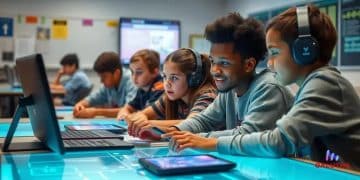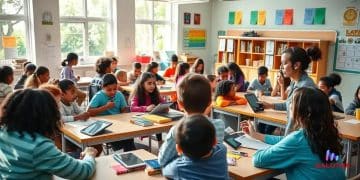The Future of Online Learning Platforms: What to Expect

The future of online learning platforms is shaped by trends like AI integration, gamification, and a focus on lifelong learning, enhancing engagement and personalizing educational experiences for students.
The Future of Online Learning Platforms is bright as technology reshapes education. Have you ever wondered how these platforms will evolve to enhance your learning experience? Let’s dive in!
The rise of virtual classrooms
The rise of virtual classrooms marks a significant shift in how education is delivered today. These online environments allow students to connect from anywhere, creating a more flexible and accessible learning experience.
Benefits of Virtual Classrooms
One of the biggest advantages is the ability to learn at your own pace. Students can revisit lectures and materials whenever they need. Additionally, virtual classrooms provide opportunities for collaboration and interaction.
- Flexible scheduling: Students can attend classes that fit their lifestyles.
- Global access: Learners from various backgrounds and locations can engage.
- Personalized learning: Educators can tailor content to meet individual needs.
Moreover, the technology that underlies virtual classrooms, such as video conferencing and interactive tools, enhances the education process. Teachers can use multimedia resources to make lessons more engaging and impactful. This adaptability not only benefits students but also allows educators to innovate their teaching methods.
Challenges to Consider
Despite the many benefits, there are challenges as well. Tech issues can disrupt lessons, and not all students learn in the same way. Ensuring student engagement can be tricky in a virtual setting. Educators must find creative ways to maintain interest.
In conclusion, the rise of virtual classrooms is transforming education, providing new opportunities while also presenting unique challenges. Understanding these dynamics is essential for teachers and students alike to thrive in this evolving landscape.
Benefits of personalized learning

The benefits of personalized learning are transforming the educational landscape. This approach tailors teaching to meet the unique needs of each student, enhancing their learning experience.
Improved Engagement
When students have a say in what and how they learn, they tend to be more engaged. Personalized learning allows them to explore topics that interest them, making education more meaningful.
- Choice: Students can select projects that resonate with their interests.
- Ownership: With customized learning paths, students feel more responsible for their education.
- Motivation: Engaged students are often more motivated to succeed.
This customization leads to better knowledge retention as students can progress at their own pace. For example, if a student struggles with a concept, they can take extra time to master it before moving on. This contrasts sharply with traditional learning, where all students move at the same speed.
Enhanced Learning Outcomes
Personalized learning strategies often result in better academic performance. When education is adjusted to fit learners’ needs, assessments can become more effective. A student who understands a topic thoroughly can move ahead to more complex materials.
Additionally, teachers can use data and feedback to tailor instruction. This means that if someone is excelling in math but not in reading, the focus can shift. This awareness is crucial for addressing learning gaps.
Ultimately, a personalized approach nurtures a love for learning. When students feel supported in their educational journey, they are more likely to develop a lifelong passion for knowledge, setting them up for future success.
The role of AI in education
The role of AI in education is becoming increasingly important. As technology advances, artificial intelligence is transforming how students learn and how teachers instruct.
Personalized Learning Experiences
AI can analyze student data to create tailored learning experiences. By understanding individual strengths and weaknesses, AI systems can offer customized resources and recommendations. This personalized approach fosters better engagement and improves understanding.
- Adaptive learning: AI adjusts the difficulty of tasks based on student performance.
- Targeted resources: Students receive content suited to their learning needs.
- Efficient feedback: AI provides immediate assessment of student work, helping learners improve.
In addition to customizing learning experiences, AI helps automate administrative tasks, freeing up teachers’ time. For instance, grading assignments and tracking student progress can be streamlined using AI tools. This allows educators to focus more on teaching and less on paperwork.
Enhanced Instructional Methods
AI also supports teachers by providing insights into classroom dynamics. With real-time data, educators can make informed decisions about lesson plans and instructional strategies. This allows for timely interventions when students struggle.
Furthermore, through virtual assistants, students can access help outside of school hours. This flexibility ensures learners receive support whenever they need it, enhancing their educational journey.
The combination of AI and education is truly revolutionary. As we continue to integrate AI technologies, the possibilities for enriched learning experiences are limitless, paving the way for a brighter future in education.
Challenges facing online learning

The challenges facing online learning are significant, and they impact both students and educators. As education shifts to digital platforms, various obstacles must be addressed.
Technology Access and Reliability
One of the main challenges is ensuring that all students have access to the necessary technology. Not everyone has reliable internet or up-to-date devices. This digital divide creates disparities in learning opportunities.
- Device availability: Not all students have laptops or tablets at home.
- Internet connectivity: Inconsistent or slow internet can hinder participation.
- Technical skills: Some students may struggle with using online tools.
In addition to access issues, maintaining engagement can be difficult in an online setting. Students may find it hard to focus without the structured environment of a classroom. This lack of in-person interaction can lead to feelings of isolation and disconnection.
Maintaining Student Engagement
To overcome this, educators need to implement strategies that foster interaction. Virtual discussions, collaborative projects, and interactive content can create a more engaging atmosphere.
Another important factor is assessing student performance. Traditional assessment methods may not work well in online settings. Teachers must adapt their evaluation techniques to ensure they accurately reflect students’ understanding and skills.
Finally, the shift to online learning puts additional pressure on instructors. They must become proficient in using technology while also adapting their teaching styles. Professional development opportunities are essential to help teachers navigate these changes effectively.
Future trends in online education
Future trends in online education are likely to reshape the way we learn. With advancements in technology, new methods are emerging that could enhance the educational experience for students and teachers alike.
Increased Use of Artificial Intelligence
AI will play a crucial role in customizing learning experiences. This technology can analyze individual learning patterns, helping to create tailored educational paths. AI-driven platforms can also provide immediate feedback to learners, making the educational process more efficient.
- Chatbots: These can assist students with queries 24/7.
- Adaptive learning: Programs that adjust content based on performance.
- Data analytics: Insights into student performance will guide improvements.
As AI becomes more integrated into online education, students will have access to interactive and engaging content that matches their pace and style of learning.
Growth of Gamification
Another exciting trend is the growth of gamification in education. By incorporating game-like elements into learning, educators can increase student motivation and engagement. This strategy makes learning more fun and helps students stay focused.
Gamified elements like points, badges, and leaderboards can encourage healthy competition and collaboration among peers. Such approaches not only enhance learning but also build essential skills in communication and teamwork.
Focus on Lifelong Learning
The future of education also emphasizes lifelong learning. With the rapidly changing job market, the need for continuous skill development becomes essential. Online platforms will likely expand offerings to include courses for professional development beyond traditional degrees.
As people seek to upskill or reskill, online education will provide flexibility to accommodate working adults. This accessibility will empower more individuals to take charge of their learning journeys.
FAQ – Frequently Asked Questions about Online Education Trends
How does AI enhance personalized learning in online education?
AI analyzes individual student data to tailor learning experiences, providing customized resources and recommendations that improve engagement and understanding.
What role does gamification play in online education?
Gamification incorporates game-like elements into learning, making it more engaging and motivating for students, which helps them stay focused and retain information.
Why is lifelong learning becoming important in today’s job market?
Lifelong learning is essential due to the fast-paced changes in job requirements. Continuous skill development allows individuals to adapt and remain competitive.
What challenges do students face in online learning environments?
Students may encounter issues like limited access to technology, difficulties with engagement, and challenges in assessment methods, which can hinder their learning experience.





